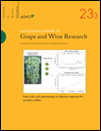Ver ítem
- xmlui.general.dspace_homeCentros Regionales y EEAsCentro Regional Mendoza - San JuanEEA MendozaArtículos científicosxmlui.ArtifactBrowser.ItemViewer.trail
- Inicio
- Centros Regionales y EEAs
- Centro Regional Mendoza - San Juan
- EEA Mendoza
- Artículos científicos
- Ver ítem
Identity and parentage of some South American grapevine cultivars present in Argentina
Resumen
Background and Aims: Based on 19 nuclear simple sequence repeat markers and parental analysis, we aimed to identify and propose the pedigree of different accessions held at the Estación Experimental Agropecuaria Mendoza of the Instituto Nacional de Tecnología Agropecuaria germplasm collection. The results were compared with data recorded in large, international databases.
Methods and Results: We identified 37 different cultivars, of which 18 were
[ver mas...]
Background and Aims: Based on 19 nuclear simple sequence repeat markers and parental analysis, we aimed to identify and propose the pedigree of different accessions held at the Estación Experimental Agropecuaria Mendoza of the Instituto Nacional de Tecnología Agropecuaria germplasm collection. The results were compared with data recorded in large, international databases.
Methods and Results: We identified 37 different cultivars, of which 18 were original and not previously identified. The parentage analysis showed that European cultivars, such as Muscat of Alexandria, Muscat à Petits Grains, Listán Prieto, Mollar Cano and Malbec, were involved in natural crossings resulting in different South American cultivars.
Conclusions: Many of the cultivars identified here represent unique individuals based on their genotype. The number of cultivars that participated as progenitors in the origin of South American germplasm is higher than previously thought.
Significance of the Study: Germplasm collections planted many years ago play a key role in the conservation and characterisation of genotypes that otherwise may have been lost. It is highly probable that there might be other genotypes not identified and mixed in old vineyards. The identification, rescue and conservation of these genotypes are a challenge to preserve the existing genetic variability.
[Cerrar]

Autor
Aliquo, Gustavo;
Torres, Maria Del Rocio;
Lacombe, Thierry;
Boursiquot, Jean-Michel;
Laucou, Valerie;
Gualpa, Jose Luis;
Fanzone, Martín Leandro;
Sari, Santiago Eduardo;
Perez Peña, Jorge Esteban;
Prieto, Jorge Alejandro;
Fuente
Australian journal of grape and wine research 23 (3) : 452–460. (October 2017)
Fecha
2017
ISSN
1322-7130 (Print)
1755-0238 (Online)
1755-0238 (Online)
Formato
pdf
Tipo de documento
artículo
Palabras Claves
Derechos de acceso
Restringido
 Excepto donde se diga explicitamente, este item se publica bajo la siguiente descripción: Creative Commons Attribution-NonCommercial-ShareAlike 2.5 Unported (CC BY-NC-SA 2.5)
Excepto donde se diga explicitamente, este item se publica bajo la siguiente descripción: Creative Commons Attribution-NonCommercial-ShareAlike 2.5 Unported (CC BY-NC-SA 2.5)

